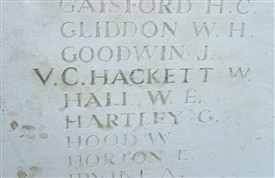HACKETT, William [of Nottingham]

William Hackett's name on the Ploegsteert Memorial
Nottinghamshire's 'Coal VC'
William Hackett was born at Nottingham on 11th June 1873, meaning that by the outbreak of the First Wold War he was already in his early forties. He tried to volunteer three times, but was rejected on each occasion owing to his age and for having a heart condition.
He had worked as a miner in the coalfields of Nottinghamshire and Yorkshire for 23 years, and it was this that ultimately proved to be his route into military service.
In October 1915 he was recruited into the 254th Tunnelling Company Corps. of the Royal Engineers, where his mining expertise would prove uniquely valuable.
At that point in the war the British were behind the Germans in tunnelling techniques, and as a mark of this urgency to catch up, Sapper William Hackett found himself in France within a month of being recruited. Seven months or so later, on 22 June 1916 - a few weeks after his 43rd birthday - he was one of five men working below ground near Givenchy driving a tunnel across No Man's Land towards the German trenches. A German mine exploded, bringing down the roof of their tunnel, trapping the men where they worked. It was for his role in subsequent events that Sapper William Hackett was awarded the VC - the only tunneller to receive this award during the conflict.
The story is recounted in his official military citation:-
"For most conspicuous bravey when entombed with four others in a gallery owing to the explosion
'I am a tunneller, I must look after the others first'
of an enemy mine. After working 20 hours, a hole was made through fallen earth and broken timber, and the outside party was met. Sapper Hackett helped three of the men through the hole and could easily have followed, but refused to leave the fourth, who had been seriously injured, saying 'I am a tunneller, I must look after the others first'. Meantime the hole was getting smaller, yet he still refused to leave his injured comrade. Finally the gallery collapsed, and though the rescue party worked desperately for four days the attempt to reach the two men failed. Sapper Hackett well knowing the nature of sliding earth, the chances against him, deliberately gave his life for his comrade".
(London Gazette, 4th August 1916)
* The fourth soldier, whom Hackett would not desert, was named Thomas Collins. Neither his body, nor that of William Hackett were ever recovered.
Family background.
At the outbreak of the First World War in 1914 William Hackett was a miner at Manvers Main Colliery at Mexborough, South Yorkshire. He was married to Alice, and they had two children, Arthur (b.1901) and Mary (b.1903).
William's enlistment papers describe him as 5ft 2.5inches tall and weighing 118 lbs.
His posthumous VC was collected by his wife from Buckingham Palace. It is now housed at the Royal Engineers Museum at Gillingham, Kent.
On his death Sapper Hackett's wife received a pension of 21 shillings for herself and their two children. Clearly William Hackett had been highly regarded by his mining colleagues, as they raised an additional sum of money for Mrs Hackett which was particularly welcome as their son, Arthur, had lost a leg in a mining accident whilst his father had been away in France.